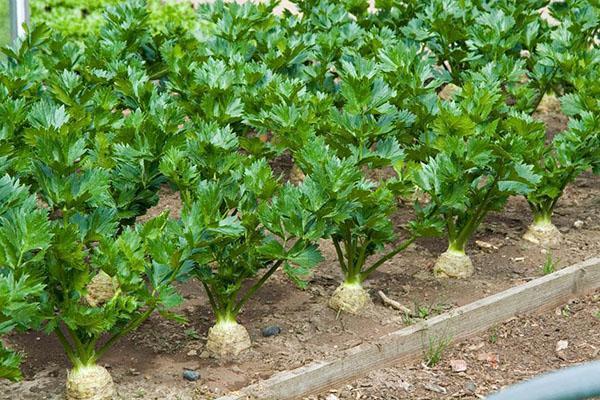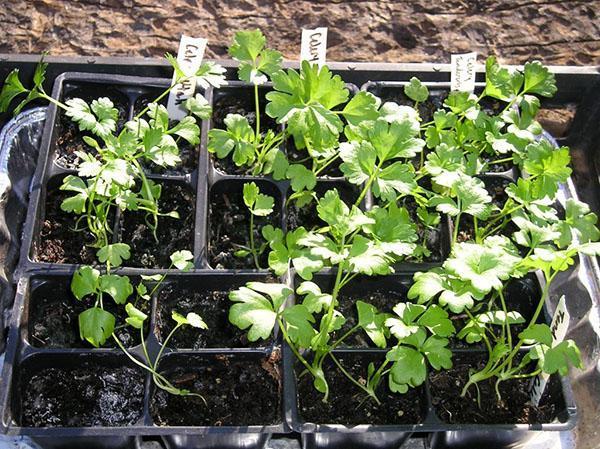Features of growing and caring for celery in the open field
 This vitamin green has long been known and loved by gardeners for its excellent taste and medicinal properties. Growing celery and caring for it in the open field will not be difficult, even for beginners, if you follow the simple rules of agricultural technology. But in return you can get tops, and roots, and even petioles! True, for this you will have to plant celery of all three types.
This vitamin green has long been known and loved by gardeners for its excellent taste and medicinal properties. Growing celery and caring for it in the open field will not be difficult, even for beginners, if you follow the simple rules of agricultural technology. But in return you can get tops, and roots, and even petioles! True, for this you will have to plant celery of all three types.
General information about celery

Growing celery outdoors requires early soil preparation. The beds for all types are prepared in the fall:
- bring phosphorus and potash fertilizers;
- add well-rotted manure or compost;
- add ash or dolomite flour for acidic soil;
- dug with a pitchfork, removing the roots of weeds;
- form beds.
For planting celery open sunny places are chosen in the ground. Recommended doses mineral fertilizers are indicated on the packaging, organics for plants need an average bucket per square meter, and the amount of dolomite flour can be calculated based on the level of soil acidity on the site. In a weakly acidic, 350-450 g per square meter is added, for an acidic one needs twice as much. If the soil is alkaline, you can do with the introduction of 100-150 g to saturate it with calcium and magnesium.
Growing celery and caring for it in the open field requires frequent watering and regular feeding with liquid organic fertilizers - mullein or nettle infusion.
With a lack of water, the leaves and petioles will be rough and fibrous, and the root crop will not reach the desired size.
When to sow seeds
 Petiole and root types of celery are sown for seedlings in February or March. Late-ripening varieties should be sown earlier. Before planting, it is advisable to soak the seeds in a pink solution of potassium permanganate, rinse and remove for 10-12 days on the lower shelf of the refrigerator, wrapped in a damp cloth. Thus, celery seeds undergo stratification and then sprout faster and more amicably.
Petiole and root types of celery are sown for seedlings in February or March. Late-ripening varieties should be sown earlier. Before planting, it is advisable to soak the seeds in a pink solution of potassium permanganate, rinse and remove for 10-12 days on the lower shelf of the refrigerator, wrapped in a damp cloth. Thus, celery seeds undergo stratification and then sprout faster and more amicably.
Timing of planting in the ground
 When to plant celery in open ground - the weather will tell you. By the time the seedlings are planted, the soil should warm up to +8 degrees. In the middle lane, this usually occurs in mid-May. Seedlings by this time should have several strong leaves, a developed root system and be hardened. To do this, she is regularly taken out to the balcony or street during the day.
When to plant celery in open ground - the weather will tell you. By the time the seedlings are planted, the soil should warm up to +8 degrees. In the middle lane, this usually occurs in mid-May. Seedlings by this time should have several strong leaves, a developed root system and be hardened. To do this, she is regularly taken out to the balcony or street during the day.
Features of agricultural culture
 Celery is planted in the soil in rows. The optimal distance between them is at least 50-60 cm, and between plants - 25 cm.
Celery is planted in the soil in rows. The optimal distance between them is at least 50-60 cm, and between plants - 25 cm.
Plants that are planted in a denser area will not receive additional nutrients and light. After planting, the seedlings are watered abundantly with water.
In the future, for good growth and development, celery is regularly watered, removed weeds and loosened.
 Growing stalked celery in the open field has some peculiarities. Starting from the middle of the season, the bushes slightly huddle, and at the end of summer, when the petioles have almost reached their presentation, they can be hilled harder and wrapped in light paper.
Growing stalked celery in the open field has some peculiarities. Starting from the middle of the season, the bushes slightly huddle, and at the end of summer, when the petioles have almost reached their presentation, they can be hilled harder and wrapped in light paper. These procedures are carried out in order to obtain bleached stems - they are softer and juicier than unbleached ones.
These procedures are carried out in order to obtain bleached stems - they are softer and juicier than unbleached ones.
Growing root celery in the open field also has subtleties, without which it is difficult to get an even and large root crop. Seedlings must be planted on the ridges without deepening. After the plant begins to form a root crop, it is necessary to regularly tear off the outer leaves, carefully trim the side roots and make sure that there are only a few thick lower roots in the ground. The soil is regularly raked and loosened from the roots. Otherwise, there is a great risk of getting a root brush instead of a rounded root crop. A few well-developed young leaves and the lowest roots are sufficient for normal growth of root celery.
After the plant begins to form a root crop, it is necessary to regularly tear off the outer leaves, carefully trim the side roots and make sure that there are only a few thick lower roots in the ground. The soil is regularly raked and loosened from the roots. Otherwise, there is a great risk of getting a root brush instead of a rounded root crop. A few well-developed young leaves and the lowest roots are sufficient for normal growth of root celery.
When removing excess leaves and roots from root celery, one should not forget about regular feeding with organic fertilizers. Then the plant will form a large root crop.
When the celery is harvested
 Harvesting of leaf celery begins as soon as the first greens grow. During the summer period, it is cut off several times. After cutting, the plant is watered and fed.
Harvesting of leaf celery begins as soon as the first greens grow. During the summer period, it is cut off several times. After cutting, the plant is watered and fed.
 The petiole and root species are harvested selectively, as individual bushes mature. It must be completed before the onset of autumn frosts, that is, until mid-October.
The petiole and root species are harvested selectively, as individual bushes mature. It must be completed before the onset of autumn frosts, that is, until mid-October.
If you follow these simple guidelines, growing and caring for celery outdoors will be easy and will result in a tasty and vitamin-rich harvest.